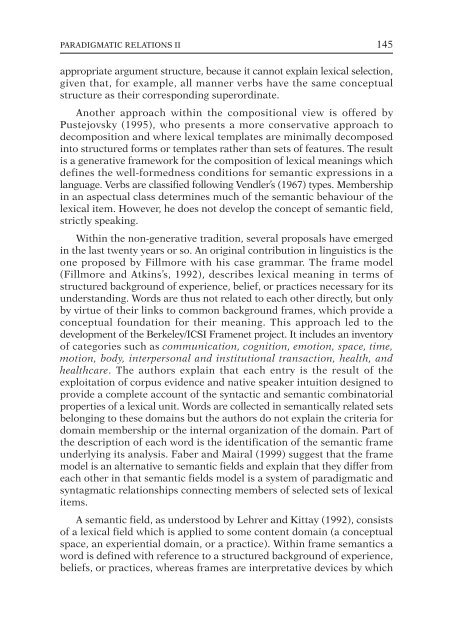Semantics
You also want an ePaper? Increase the reach of your titles
YUMPU automatically turns print PDFs into web optimized ePapers that Google loves.
PARADIGMATIC RELATIONS II 145<br />
appropriate argument structure, because it cannot explain lexical selection,<br />
given that, for example, all manner verbs have the same conceptual<br />
structure as their corresponding superordinate.<br />
Another approach within the compositional view is offered by<br />
Pustejovsky (1995), who presents a more conservative approach to<br />
decomposition and where lexical templates are minimally decomposed<br />
into structured forms or templates rather than sets of features. The result<br />
is a generative framework for the composition of lexical meanings which<br />
defines the well-formedness conditions for semantic expressions in a<br />
language. Verbs are classified following Vendler’s (1967) types. Membership<br />
in an aspectual class determines much of the semantic behaviour of the<br />
lexical item. However, he does not develop the concept of semantic field,<br />
strictly speaking.<br />
Within the non-generative tradition, several proposals have emerged<br />
in the last twenty years or so. An original contribution in linguistics is the<br />
one proposed by Fillmore with his case grammar. The frame model<br />
(Fillmore and Atkins’s, 1992), describes lexical meaning in terms of<br />
structured background of experience, belief, or practices necessary for its<br />
understanding. Words are thus not related to each other directly, but only<br />
by virtue of their links to common background frames, which provide a<br />
conceptual foundation for their meaning. This approach led to the<br />
development of the Berkeley/ICSI Framenet project. It includes an inventory<br />
of categories such as communication, cognition, emotion, space, time,<br />
motion, body, interpersonal and institutional transaction, health, and<br />
healthcare. The authors explain that each entry is the result of the<br />
exploitation of corpus evidence and native speaker intuition designed to<br />
provide a complete account of the syntactic and semantic combinatorial<br />
properties of a lexical unit. Words are collected in semantically related sets<br />
belonging to these domains but the authors do not explain the criteria for<br />
domain membership or the internal organization of the domain. Part of<br />
the description of each word is the identification of the semantic frame<br />
underlying its analysis. Faber and Mairal (1999) suggest that the frame<br />
model is an alternative to semantic fields and explain that they differ from<br />
each other in that semantic fields model is a system of paradigmatic and<br />
syntagmatic relationships connecting members of selected sets of lexical<br />
items.<br />
A semantic field, as understood by Lehrer and Kittay (1992), consists<br />
of a lexical field which is applied to some content domain (a conceptual<br />
space, an experiential domain, or a practice). Within frame semantics a<br />
word is defined with reference to a structured background of experience,<br />
beliefs, or practices, whereas frames are interpretative devices by which



